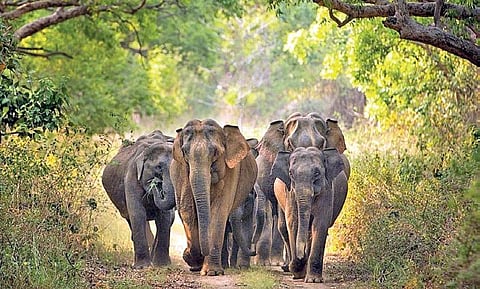

BHUBANESWAR: Nine elephant corridors in the state have recorded a decrease in use by pachyderms and one is impaired. However, elephant movement in three other corridors has increased, reveals the Elephant Corridors of India 2023 report.
Odisha, part of East Central zone, has 14 elephant corridors including four inter-state corridors including Telkoi-Pallahada; Karo- Karampada; Deuli-Suliapada; Similipal-Hadagarh-Kuldiha (Simlipal-Satkosia)
(Baula-Kuldiha); Maulabhanja-Jiridamali-Anantapur; Kanheijena-Anantapur; Nuagaon-Baruni; Buguda-Central reserve forest; Tal-Kholgarh; Barapahad-Tarva-Kantamal; Kotagarh- Chandrapur; Karlapat-Urladani; Badampahar-Dhobadhobin; Badampahar-Karida East.
The total length of the corridors is around 387.27 km. Karo-Karampada; Deuli-Suliapada (connecting West Bengal) and Badampahar -Dhobadhobin (connecting Jharkhand) along with Badampahar-Karida East are inter-state corridors, while the rest 10 are within the state.
With a total length of 77 km, the Kotagarh-Chandrapur corridor that connects Kotagarh wildlife sanctuary to Pankhalgudi reserve forest in Muniguda range of Rayagada is the longest elephant corridor of the state and the Buguda-Central RF corridor is shorter with a total length of 2.6 km.
The report revealed elephant movement has decreased in Karlapat-Urladani corridor, Badampahar-Dhobadhobin inter-state corridor, Buguda-Central corridor, Kanheijena-Anantapur corridor, Karo-Karampada interstate corridor, Tal-Kholgarh corridor, Badampahar-Karida East interstate corridor, Barapahad-Tarva-Kantamal corridor and Maulabhanja-Jiridamali-Anantapur.
On the other hand, the 72 km Deuli-Suliapada inter-state corridor, having Sal-dominated secondary deciduous forests, has been impaired over the years as elephant movement has shifted to Rasgobindpur and Betnoti Ranges, all the way up to Nilagiri outside Kuldiha wildlife sanctuary.
“The corridor is seldom used by the elephants,” the report revealed. It, however, suggested elephant movement on the 30.4 km long Telkoi-Pallahara corridor, 4.5 km long Nuagaon-Baruni corridor and 77 km long Kotagarh-Chandrapur corridor has increased. In Similipal-Hadgarh corridor, notified as Similipal-Hadgarh-Kuldiha conservation reserve by the state government recently, elephant movement is constant.
As per the report, agricultural fields, human settlements and linear infrastructures such as roads, highways and railway tracks along with other linear infrastructure are the major bottleneck in protection of elephant corridors. In corridors including Nuagaon-Baruni where there has been no disruptions, the report of the Project Elephant suggested the state government notify them immediately for protection under appropriate law. In other cases, it has suggested appropriate measures including public awareness, enforcement against encroachment and preventive measures against wildfire, poaching activities to clear the hurdles.
Jumbo concern
Nine corridors have recorded decline in use by elephants
Movement in three corridors has increased
The report has suggested several measures to protect the gentle giants